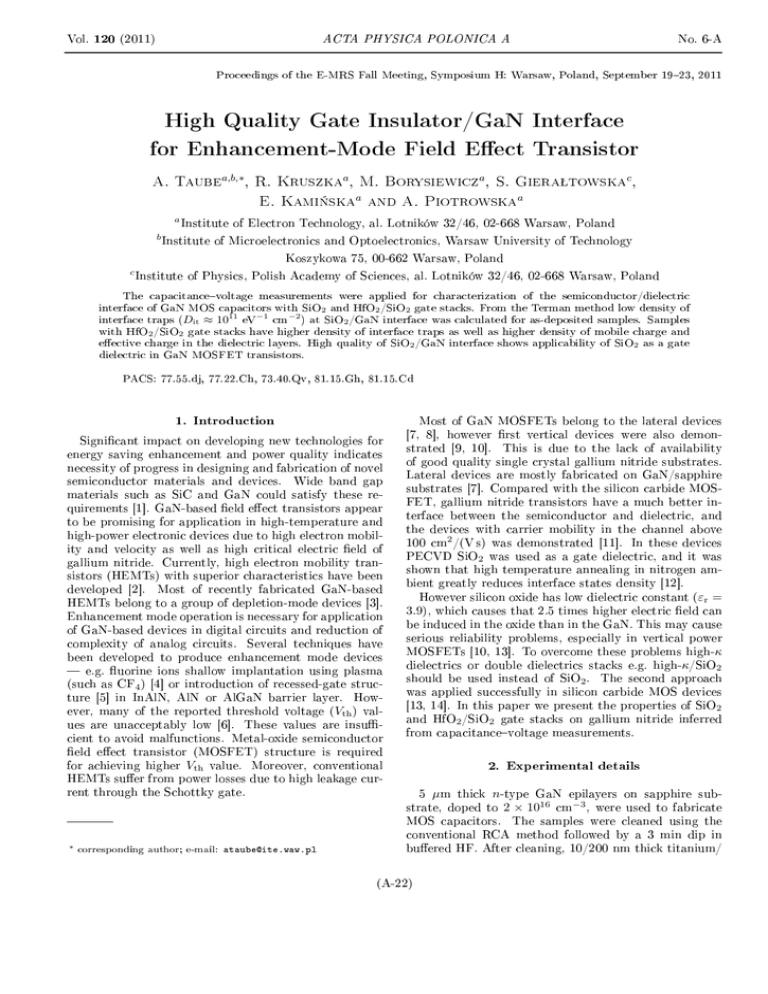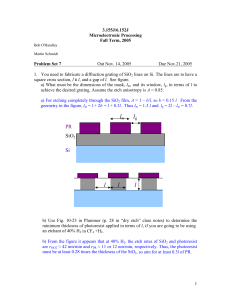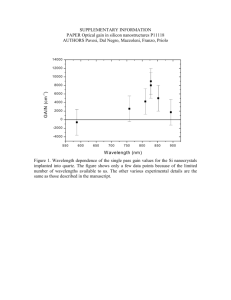High Quality Gate Insulator/GaN Interface for Enhancement
advertisement

Vol. 120 (2011) No. 6-A ACTA PHYSICA POLONICA A Proceedings of the E-MRS Fall Meeting, Symposium H: Warsaw, Poland, September 1923, 2011 High Quality Gate Insulator/GaN Interface for Enhancement-Mode Field Eect Transistor a,b,∗ A. Taube a E. Kami«ska a b a c , R. Kruszka , M. Borysiewicz , S. Gieraªtowska , a and A. Piotrowska a Institute of Electron Technology, al. Lotników 32/46, 02-668 Warsaw, Poland Institute of Microelectronics and Optoelectronics, Warsaw University of Technology Koszykowa 75, 00-662 Warsaw, Poland c Institute of Physics, Polish Academy of Sciences, al. Lotników 32/46, 02-668 Warsaw, Poland The capacitancevoltage measurements were applied for characterization of the semiconductor/dielectric interface of GaN MOS capacitors with SiO2 and HfO2 /SiO2 gate stacks. From the Terman method low density of interface traps (Dit ≈ 1011 eV−1 cm−2 ) at SiO2 /GaN interface was calculated for as-deposited samples. Samples with HfO2 /SiO2 gate stacks have higher density of interface traps as well as higher density of mobile charge and eective charge in the dielectric layers. High quality of SiO2 /GaN interface shows applicability of SiO2 as a gate dielectric in GaN MOSFET transistors. PACS: 77.55.dj, 77.22.Ch, 73.40.Qv, 81.15.Gh, 81.15.Cd Most of GaN MOSFETs belong to the lateral devices 1. Introduction Signicant impact on developing new technologies for energy saving enhancement and power quality indicates necessity of progress in designing and fabrication of novel semiconductor materials and devices. Wide band gap materials such as SiC and GaN could satisfy these requirements [1]. GaN-based eld eect transistors appear to be promising for application in high-temperature and high-power electronic devices due to high electron mobility and velocity as well as high critical electric eld of gallium nitride. Currently, high electron mobility transistors (HEMTs) with superior characteristics have been developed [2]. Most of recently fabricated GaN-based HEMTs belong to a group of depletion-mode devices [3]. Enhancement mode operation is necessary for application of GaN-based devices in digital circuits and reduction of complexity of analog circuits. Several techniques have been developed to produce enhancement mode devices e.g. uorine ions shallow implantation using plasma (such as CF4 ) [4] or introduction of recessed-gate structure [5] in InAlN, AlN or AlGaN barrier layer. However, many of the reported threshold voltage (Vth ) values are unacceptably low [6]. These values are insu- cient to avoid malfunctions. Metal-oxide semiconductor [7, 8], however rst vertical devices were also demonstrated [9, 10]. This is due to the lack of availability of good quality single crystal gallium nitride substrates. Lateral devices are mostly fabricated on GaN/sapphire substrates [7]. Compared with the silicon carbide MOSFET, gallium nitride transistors have a much better interface between the semiconductor and dielectric, and the devices with carrier mobility in the channel above 2 100 cm /(V s) was demonstrated [11]. In these devices PECVD SiO2 was used as a gate dielectric, and it was shown that high temperature annealing in nitrogen ambient greatly reduces interface states density [12]. However silicon oxide has low dielectric constant (εr 3.9), = which causes that 2.5 times higher electric eld can be induced in the oxide than in the GaN. This may cause serious reliability problems, especially in vertical power MOSFETs [10, 13]. To overcome these problems high-κ dielectrics or double dielectrics stacks e.g. high-κ/SiO2 should be used instead of SiO2 . The second approach was applied successfully in silicon carbide MOS devices [13, 14]. In this paper we present the properties of SiO2 and HfO2 /SiO2 gate stacks on gallium nitride inferred from capacitancevoltage measurements. eld eect transistor (MOSFET) structure is required Vth value. Moreover, conventional HEMTs suer from power losses due to high leakage cur- for achieving higher 2. Experimental details rent through the Schottky gate. 5 µm thick n-type GaN epilayers on sapphire sub2 × 1016 cm−3 , were used to fabricate strate, doped to MOS capacitors. The samples were cleaned using the conventional RCA method followed by a 3 min dip in ∗ corresponding author; e-mail: ataube@ite.waw.pl buered HF. After cleaning, 10/200 nm thick titanium/ (A-22) A-23 High Quality Gate Insulator/GaN Interface . . . aluminum bilayer was sputter-deposited and annealed ◦ at 900 C to form ohmic contact. Two types of samples were fabricated. The rst one with 30 nm thick SiO2 layer deposited by plasma enhanced chemical vapor deposition (PECVD), and the second with 10 nm PECVD-grown SiO2 pedestal layer followed by DC magnetron sputtered 45 nm thick HfO2 layer. Silicon oxide layer was deposited using SiH4 (2% in N2 ) and N2 O gases. Hafnium oxide lm was reactively sputtered from hafnium target at room temperature in O2 /Ar (70%/ 30%) ambient. After deposition of SiO2 , thermal annealing was performed in N2 ambient for 30 min at tem◦ peratures from the range 8001000 C. Finally, metal Fig. 2. Hysteresis eect in C V characteristics of SiO2 /GaN and HfO2 /SiO2 /GaN MOS capacitors. oxidesemiconductor (MOS) capacitors were fabricated by depositing and patterning of 10 nm/200 nm thick Ti/Al electrodes. MOS capacitors was characterized by measurements of capacitancevoltage characteristic (at 1 MHz) on Agilent 1500B semiconductor parameter analyzer with Cascade Summit 12000AP probe station. 3. Results and discussion Figure 1a shows the eect of annealing on the measured and normalized capacitancevoltage characteristic of SiO2 /GaN MOS capacitors. As we can see, due to Fig. 3. Interface state density (Dit ) of SiO2 /GaN and HfO2 /SiO2 /GaN. As we can see in Fig. 2a, hysteresis in SiO2 /GaN capacitors is very small in comparison with HfO2 /SiO2 /GaN structures. Large hysteresis in double dielectric stack is attributed to mobile charge which is located in HfO2 layer. Obtained results from VFB , Qeff , and hysteresis width are presented in Table. Minimum density of eective charge and minimum hysteresis width for both type ◦ of structures, are obtained for samples annealed in 900 C Fig. 1. (a) Normalized C V characteristics of SiO2 / GaN MOS capacitors. (b) Normalized C V characteristics of HfO2 /SiO2 /GaN MOS capacitors. and as-deposited samples, respectively. Capacitance of MIS structure in accumulation regime Cox . From this eective dielectric constant could be calculated. Assuming that SiO2 dielectric is equal to κ characteristics were shifted towards neg- constant is equal to 3.9, hafnium oxide dielectric constant ative voltages, which indicates increase of positive eec- was estimated to be about 15, which is comparable with tive charge density in SiO2 layer. Eective charge can be calculated using the following formula [15]: results reported in literature [16]. C V annealing ( Qeff = −Cox ) VFB − φms , q Terman method was applied to calculate the interface state density by tting the experimental curves at room (1) temperature with theoretical ones [17]. state density is plotted in Fig. 3. The interface The lowest interface characteristics were shifted towards posi- state density was obtained for as-deposited SiO2 /GaN 11 −1 −2 samples (Dit ≈ 10 eV cm ). For HfO2 /SiO2 /GaN structures the lowest Dit was obtained for samples with ◦ SiO2 pedestal layer annealed at 800 and 1000 C, how- tive voltages, which is associated with the occurrence of a ever these values are about one order of magnitude higher negative charge. Deposition of hafnium oxide changes the than in case of as-deposited SiO2 /GaN samples. where Cox is oxide capacitance, VFB is atband voltage φms is work function dierence between gate metal and semiconductor. In case of HfO2 /SiO2 gate stacks and (Fig. 1b) C V sign of the charge, which suggests existence of large positive charge in sputtered HfO2 layers. Figure 2 presents C V characteristics measured from hysteresis eect in inversion to accumulation and in the opposite direction. A-24 A. Taube et al. TABLE Eective oxide charges and hysteresis width for SiO2 /GaN and HfO2 /SiO2 /GaN capacitors. SiO2 annealing temperature as-deposited 800 ◦C 900 ◦C 1000 ◦C SiO2 /GaN Qeff [cm2 ] Hysteresis [V] 6.8 × 1011 3.4 × 1011 2.5 × 1012 4.1 × 1012 0.03 0.21 0.18 0.02 4. Conclusions In this paper an investigation of SiO2 /GaN and HfO2 / SiO2 /GaN MOS capacitors has been presented. It has been demonstrated that PECVD-grown SiO2 layer on GaN creates high quality interface with interface state 11 −1 −2 density of about 1 × 10 eV cm near conduction band edge. High temperature annealing of SiO2 layer raises the density of interface states and the eective charge in the insulator. HfO2 /SiO2 double dielectric stack has higher interface trap density and an opposite sign of eective charge compared to SiO2 /GaN samples. Also, hysteresis width is about one order of magnitude higher in HfO2 /SiO2 samples. Process parameters of deposition of HfO2 layer should be further optimised for GaN based devices. The low density of interface states at SiO2 /GaN interface will allow the use of silicon oxide gate dielectric in gallium nitride MOSFET technology. Acknowledgments The research was partially supported by the European Union within European Regional Development Fund, through grant Innovative Economy (POIG.01.01.02-00-108/09, MIME). Sylwia Gieraªtowska was supported by the European Union within European Regional Development Fund, through grant Innovative Economy (POIG.01.01.02-00-008/08). References [1] J. Szmidt, Elektronika 9, 5 (2006). [2] J.W. Chung, W.E. Hoke, E.M. Chumbes, T. Palacios, IEEE Electron Device Lett. 31, 195 (2010). [3] J.-C. Gerbedoen, A. Soltani, S. Joblot, J.-C. De Jaeger, C. Gaquière, Y. Cordier, F. Semond, IEEE Trans. Electron Dev. 57, 1497 (2010). HfO2 /SiO2 /GaN Qeff [cm2 ] Hysteresis [V] −8.3 × 1011 −6.4 × 1011 −2.6 × 1012 −6.7 × 1011 2.13 2.55 2.56 2.03 [4] Y. Cai, Z. Cheng, W.Ch.W. Tang, K.M. Lau, K.J. Chen, IEEE Trans. Electron Dev. 53, 2223 (2006). [5] Sh. Jia, Y. Cai, D. Wang, B. Zhang, K.M. Lau, K.J. Chen, Phys. Status Solidi C 3, 2368 (2006). [6] R. Chu, Ch.S. Suh, M.H. Wong, N. Fichtenbaum, D. Brown, L. McCarthy, S. Keller, F. Wu, J.S. Speck, U.K. Mishra, IEEE Electron Device Lett. 28, 781 (2007). [7] W. Huang, T. Khan, T.P. Chow, IEEE Electron Dev. Lett. 27, 796 (2006). [8] W. Huang, T.P. Chow, Y. Niiyama, T. Nomura, S. Yoshida, IEEE Electron Dev. Lett. 30, 1018 (2009). [9] H. Otake, K. Chikamatsu, A. Yamaguchi, T. Fujishima, H. Ohta, Appl. Phys. Express 1, 011105 (2008). [10] M. Kodama, M. Sugimoto, E. Hayashi, N. Soejima, O. Ishiguro, M. Kanechika, K. Itoh, H. Ueda, T. Uesugi, T. Kachi, Appl. Phys. Express 1, 021104 (2008). [11] K. Yamaji, M. Noborio, J. Suda, T. Kimoto, Jpn. J. Appl. Phys. 47, 7784 (2008). [12] Y. Niiyama, T. Shinagawa, Sh. Ootomo, H. Kambayashi, T. Nomura, S. Yoshida, Phys. Status Solidi A 204, 2032 (2007). [13] A. Taube, M.Sc. Thesis, Warsaw University of Technology, Warsaw 2011. [14] K.Y. Cheong, J.H. Moon, D. Eom, H.J. Kim, W. Bahng, N.-K. Kim, Electrochem. Solid State Lett. 10, H69 (2007). [15] M. Grundmann, The Physics of Semiconductors, Springer, Berlin 2006. [16] A. Taube, S. Gieraªtowska, T. Gutt, T. Maªachowski, I. Pasternak, T. Wojciechowski, W. Rzodkiewicz, M. Sawicki, A. Piotrowska, Acta Phys. Pol. A 119, 696 (2011). [17] L.M. Terman, Solid-State Electron. 5, 285 (1962).



